The 2016 World T20 might only be the sixth edition of the tournament but it has already provided plenty of memorable moments that fans will cherish forever. While some can hold their heads proudly for the records that they hold, not everyone has been so lucky.
In fact, despite the short space of time, there have already been plenty of records that the players wouldn’t want to be associated with their name, but unfortunately, will. Whether that is for their slow batting or expensive bowling, there are numerous unwanted World T20 records.
Here are the 6 most unwanted World T20 records:
#1 Lowest team score

Four of the top five lowest World T20 totals came in the last World T20. The lowest of all came by Netherlands, who could only manage 39 against Sri Lanka in 2014. After being asked to bat by Sri Lanka, the Dutch didn’t give a good account of themselves as they were bowled out for the lowest team score in a World T20 match.
Their run rate of 3.71 is the lowest by any team in a completed innings and it was also the only time that a team had scored fewer than 50 runs. Only one batsman, Tom Cooper, managed to get to double digits while there were five players who finished with 0, which was one shy of a world record of most ducks in an innings.
Although they lost a wicket, Sri Lanka got there in just five overs, thereby handing the Dutch a humiliating loss.
#2 Most runs conceded by a bowler in a single innings
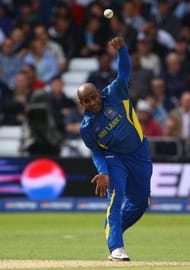
In the history of the World T20, only four bowlers have conceded 60 or more. And while Stuart Broad is among one of them, he isn't the bowler who has conceded the most runs. That dubious honour goes to Sri Lanka's Sanath Jayasuriya.
In the Group F game against Pakistan in the 2007 World T20, Jayasuriya finished with figures of 4-0-64-0. Pakistan were struggling at 49/3 when he came on to bowl in the ninth over and it was his spell that gave them the momentum and helped them post a massive total of 189/6.
Shoaib Malik, Younis Khan and Misbah-ul-Haq were especially hard on Jayasuriya, with all three of them hitting him for at least a six and having a strike rate in excess of 200 against him. None of his overs went for less than 12 runs and at the time, his spell was the worst bowling figures in T20I history along with James Anderson. Thankfully for him, Kyle Abbott overtook Sanath by conceding 68 runs against West Indies last year.
What made matters even worse was that not only did Jayasuriya fail with the ball but he also couldn't do anything with the bat as Pakistan won the match by a comfortable margin.
#3 Most ducks
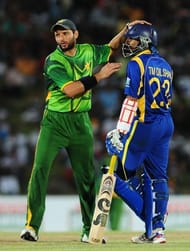
When you play 30 and 31 matches respectively, the odds of failure increase by some margin. When your name is Shahid Afridi, who goes boom or bust in every innings, those odds increase even more. So it is no surprise to see that the Pakistan captain leads the list when it comes to most ducks in World T20.
Somewhat surprising is that the other batsman who jointly holds the record is Sri Lanka's opener Tillakaratne Dilshan, the third-leading run-scorer in World T20 history. Both batsmen have been out for a duck five times and since they are both playing in the 2016 World T20, they will be hoping that the number doesn't increase.
The record for the most consecutive ducks is jointly-held by Bangladesh's Imrul Kayes and Kenyan wicketkeeper Morris Ouma, who were both out for 0 in two successive games. The interesting bit about that is that both players are not only openers but have only played two World T20 matches and are thus yet to score a World T20 run.
#4 Worst economy rate in a single innings
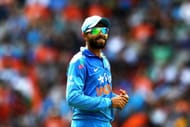
Long before Ravindra Jadeja became a regular feature in the Indian side, he became infamous for a spell he bowled in the 2010 World T20 against Australia. India lost the match by 49 runs and Jadeja finished with the worst economy rate by a bowler in a World T20 innings.
Jadeja came on to bowl as first change and when he started in the fourth over, Australia were 16/0. But in his very first over, Shane Watson smashed for three successive sixes and ensured they were up and away in the powerplay.
After Irfan Pathan had managed to bring things back a little with a couple of tight overs that went for just 10 runs, Jadeja came back to bowl in the 10th over. The first three balls of his second over were greeted by David Warner with three consecutive sixes. And after that over, when Jadeja had figures of 2-0-38-0, he didn't bowl again in the match.
But what was even more surprising was the fact that aside from those six sixes, the left arm spinner's other six balls went for just two singles and had four dots.
#5 Most expensive over
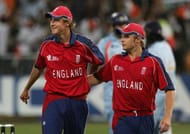
The most expensive over in the history of World T20s is one that every Indian fan will remember for the rest of their lives. Having gone into the inaugural World T20 without much experience of the format and under a new captain, India weren't supposed to pull up too many trees but the game against England changed all of that.
When Yuvraj Singh walked into bat India had a solid platform and looked as though they had an outside chance of getting to 200. But his innings changed the entire complexion of the game. He hit Stuart Broad for six sixes in an over and became only the second batsman after Herschelle Gibbs to achieve that feat.
In the process, he also hit the fastest fifty in all formats of cricket, when he got there in just 12 balls, a record that has stood for nearly 9 years now. That Yuvraj innings and over made people sit up and take notice of India and etched Broad's name into the annals of T20I and World T20 history for all the wrong reasons.
#6 Worst strike rate in a single innings
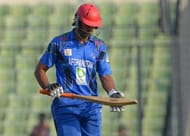
T20 is the format that changed the meaning of the term strike rates forever. At the time when the format was introduced, strike rates of 80 were considered good and players who had a strike rate close to 100 were considered extremely impressive but now even double that is not uncommon. So when you find out that the worst strike in an innings where a batsman played at least 10 balls is under 10, you know there must have been some seriously bad batting.
There have been six batsmen who had a strike rate of 20 or under having played at least 10 balls. The record for the worst strike rate in a single innings goes to Shapoor Zadran who completed his innings with a strike rate of 9.09 in the 2014 World T20 qualifier against Bangladesh. The fast bowler scored just 1 run off his 11 balls as Afghanistan were bowled out for just 72. Unsurprisingly the total was chased easily by Bangladesh.
While that was in a qualifier, the record for the worst strike in a World T20 match is held by Sri Lanka's Tillakaratne Dilshan, who had a strike rate of just 15.78 in the 2010 World T20 Group game against New Zealand. After Sri Lanka won the toss and elected to bat, Dilshan, who opened alongside Mahela Jayawardene finished with just 3 runs from 19 balls.
It was his innings that sucked the momentum out of the Sri Lankan batting and resulted in them only scoring 135 despite a 51-ball 81 from Jayawardene. In the end, that proved to be decisive as New Zealand won the game with a ball to spare and just two wickets in hand.
Follow IPL Auction 2025 Live Updates, News & Biddings at Sportskeeda. Get the fastest updates on Mega-Auction and cricket news
